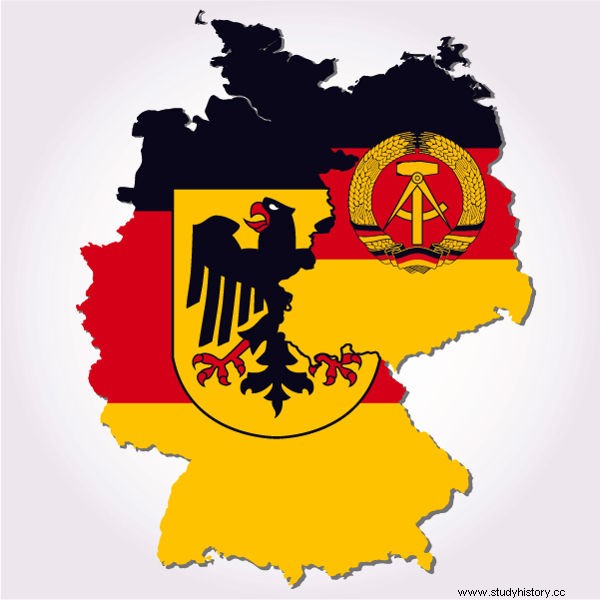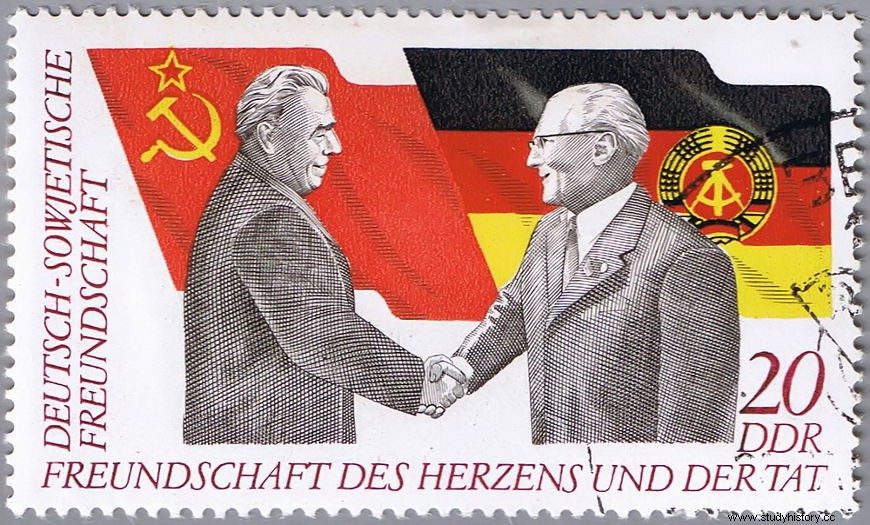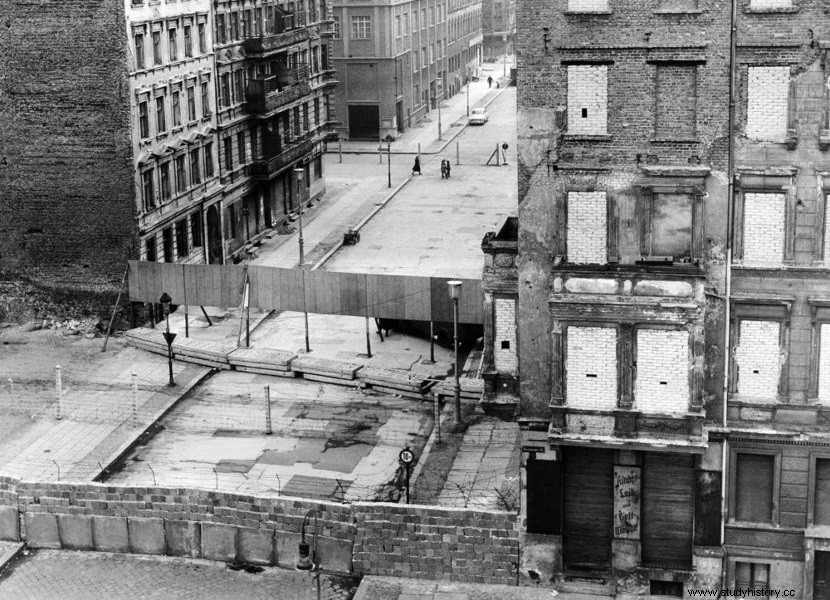The Berlin Wall was a structure built in 1961 that surrounded the boundaries of West Berlin, capital of West Germany. This wall was one of the great symbols of the Cold War and was built by decision of the authorities of East Germany and the Soviet Union. Their objective was to isolate West Berlin of East Germany.
The Berlin Wall existed for nearly three decades and was responsible for stemming the flow of people moving from East Germany to West Germany. It is estimated that, during the existence of the wall, more than 100 people died trying to cross it. The Berlin Wall came down in 1989 as the communist bloc began to crumble in Eastern Europe.
Also visit :Understand one of the events that marked the Cold War
Historical context

In the early 1960s, the territory of today's Germany was divided into two different nations. These were:
-
Federal Republic of Germany (RFA):also known as Germany Western , had West Berlin as its capital. It was an ally of the US and therefore part of the capitalist bloc.
-
German Democratic Republic (GDR):also known as Germany Oriental , had East Berlin as its capital. It was an ally of the USSR and therefore part of the communist bloc.
This division of Germany was a direct result of the outcome of the Second World War in 1945. After the Nazis were defeated in the Battle of Berlin, German territory was divided into zones of influence and occupied by the British, French, Germans and Soviets. This division was also reproduced in Berlin, and the territories occupied there eventually formed the FRG and the GDR.
-
Cold War
The division of Germany is directly related to the Cold War, the political-ideological conflict in which the communist bloc and the capitalist bloc fought for world hegemony. This combat began to take shape shortly after the Second World War and became a reality in 1947. The division of Germany into two nations was confirmed in 1949, when the two aforementioned republics emerged.
The Cold War had in the North Americans and the Soviets two great world powers that were vying for hegemony, and this dispute took place on all continents. In the case of Germany, it was more intense, mainly because it was the country in which the war in Europe ended and because it is a strategic location in the context of the dispute between USA and USSR.
If you are interested in knowing more about what the Cold War was and about its impact on 20th century geopolitics, we suggest reading this text.
Why was the Berlin Wall built?
The construction of the Berlin Wall is related to thepopulation flight from East Germany to West Germany throughout the 1950s and early 1960s. The Cold War dispute was directly reflected in a competition between the two Germanys, although West Germany's advantage was notorious.
This one received heavy investment from the United States via the Marshall Plan, and so its economy prospered rapidly. West German economic figures were substantially better compared to East Germany. In addition to investments, this situation was explained by the fact that West Germany had more population and more features.
Besides economics, there was a fundamental question that separated the two Germanys:the freedom . The repression imposed in East Germany was coordinated by the secret police, the Stasi , which had thousands of informants spread across the territory of the FRG. Repression was not exclusive to East Germany, but to every bloc under Soviet influence.

These factors have led to a massive population exodus in East Germany, and from 1948 to 1961, 2.7 million people moved from East Germany to West Germany, according to a survey by sociologist and journalist Jayme Brener.|1| Among these millions of people, there were a large number of teachers, doctors and engineers.
The situation was an emergency for East Germany, as the loss of labor, especially skilled labor, posed a risk to the country's economic development. This situation attracted the attention of the GDR authorities, mainly from 1958 onwards. Thus, to prevent this flow of people from increasing, the Stasi has been mobilized.
This population flight became known among GDR authorities as Republikflucht , and the use of Stasi was not enough to contain the situation. It was this police that suggested the physical closing of borders as the only effective way to reduce the flight of citizens. Taking this advice into consideration, Walter Ulbricht, leader of the GDR, asked Moscow for permission to close the border.
Also visit :The crisis that started the most tense moment of the Cold War
Building the Berlin Wall
The construction of the Berlin Wall was the result of deliberations and negotiations that dragged on for months between the German (GDR) and Soviet authorities. Ulbricht's request was made in May, the Soviet authorization was given in June, and construction of the wall did not begin until August 1961. This was part of Operation Pink .
The operation to build the wall was conducted in an extremely secret manner. , as it was feared a reaction from Western nations, as well as fears that, if the information was leaked, a huge number of people would flee at the last minute. Historian Patrick Major says that in the GDR, only 60 people knew of its existence.|2|
The Soviets then began silent preparations for Operation Rosa, and command was handed over to Erich Honecker (President of East Germany from 1976 to 1989). The intelligence services of Western nations had evidence that the GDR could take action to close the borders. However, there was no mobilization to prevent this from happening, because it was not known when it would happen.

The Soviets and Germans determined that the operation would take place at the crossing from the 12th of August to the 13th. That dawn, thousands of Russian tanks took over the streets of Berlin and, in the morning, the GDR soldiers had already positioned themselves on the borders between East Berlin and West Berlin, thousands of meters deep. barbed wire that closed the border between the two cities.
Over the next few months, the necessary actions were carried out that implemented several kilometers of concrete wall, security towers, electrified fences, and put teams in place monitoring the wall 24 hours a day . The monitoring was carried out by soldiers of the East German army who, in addition to heavy weapons, had guard dogs at their disposal.
The closing of the border and the construction of the Berlin Wall managed to practically end the exodus of citizens to West Germany. It is estimated that, after the wall, only about 5,000 East Germans managed to flee the country, and between 1961 and 1989, 140 people died trying to cross it .
Also visit :See attempt at political reform in a failed communist nation
Fall of the Berlin Wall
The fall of the Berlin Wall was a result of the crisis policy and economic that hit East Germany in the 1980s. This crisis in the GDR ended up motivating protests against the situation in the country, and these included demonstrations against authoritarianism and the lack of freedom that marked it.
Dissatisfaction with the situation in East Germany led thousands of East German citizens to seek refuge in other nations, and this situation gained strength when Hungary decreed the opening of its borders with the West. , in 1989. This opening was one of the targets of the demonstrations that spread in East Germany.
On November 9, 1989, a new law on citizen mobility and border status was announced. Government spokesman Günther Schabowski , in turn, announced that the law would enter into force immediately, when, in fact, it would only be valid if approved in Parliament. The announcement mobilized a crowd that gathered at the border crossings, eager to cross to West Berlin.
The agglomeration of people ended up putting the East German government in a delicate situation, and so the borders were released and people allowed to go to West Berlin. At the turn of the 10th to the 11th of November 1989, the population clustered around the wall began to deprecate it. It was the symbolic act of the fall of the Berlin Wall. The following year, Germany was reunified .
Notes
|1| BRENER, Jayme. Eastern Europe :the democratic revolution. São Paulo:Ática, 1990, p. 104.
|2| The secret story of how the Berlin Wall was built by East Germany and the Soviet Union. To access, click here.
Image credit
[1] brandonht and Shutterstock
Take the opportunity to check out our video lesson related to the subject:
